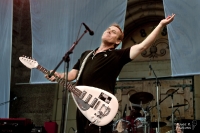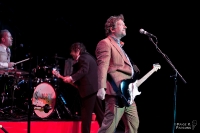When I first heard about the English Beat/Squeeze double bill at the Mountain Winery in Saratoga, CA, I wasn’t that keen to go. After all, this version of the English Beat features only one original member, Dave Wakeling. The re-formed Squeeze fares a little better, with both songwriting partners Difford & Tilbrook, and early (if not founding) member John Bentley, but no Jools Holland. There’s always the risk that an older band will have lost its original magic, and will act as a diabolical mirror, showing the fans just how much they themselves have aged. But it was clear from the opening of the show that these musicians are not too concerned with capturing a lost past.
Starting promptly at 7:30, despite a late sound check, the English Beat’s set seemed shorter than its 70-minute running time. Reportedly playing without a set list, Wakeling and toastmaster Antonee First immediately put some effort into getting the largely middle-aged audience on their feet, with a rapid rundown of the more mainstream Beat and General Public hits, and a brief foray into old-style ska with “Ranking Full Stop”. First made a winning substitute for the original Ranking Roger. Wakeling tried some tricky little variations on old favorites, mixing a verse of Pearl Jam’s “Better Man” into “Save It for Later”, and ending “Tenderness” with a new and beautiful harmonic arrangement. “Mirror in the Bathroom” didn’t quite live up to the original version, without Saxa, but the vocal power in “I Confess”, and Wakeling’s charmingly odd whistling on “Never You Done That” made those renditions as enjoyable as the recordings. Dave Wakeling seems out to prove Elvis Costello’s theory that his place is on the concert stage, and to glory in an audience enjoying themselves.
Wakeling’s croon seems only to have lost a few of the higher falsetto notes, retaining the familiar buttery tones (in contrast to his impish and rough-voiced offstage persona). Glenn Tilbrook of Squeeze also seems to have kept most of his sound, as did partner Chris Difford. (News to me: much of Squeeze’s memorable vocal quality comes merely from Tilbrook and Difford using their respectively smooth and gravelly voices at the same time.)
It was obvious from the switch between the two bands that Squeeze spared little expense in presenting themselves as a professional headliner. However, they could have saved some money on lighting and video, because the lineup itself was more than impressive, and the huge video backdrops merely distracting. Simon Hanson, sporting an upright quiff of blonde hair, was a whirl of drumsticks, while sweet-faced John Bentley, less pyrotechnic and appearing much younger than his real age, played everything perfectly and contributed flawless backing vocals. Stephen Large added lots of crowd-pleasing showmanship, demonstrating his skill on the iPad during “Cool for Cats,” karate-chopping his way through an electronica solo, and miraculously hitting every note when playing the keyboard with his high-top-clad foot. More than one lady in the audience begged photographer Ms. Parsons for closeups of “Lord Large” (described by Tilbrook as “officially the skinniest member of Squeeze, three years running”).
Squeeze’s long roster of hits, and the band’s infectious joy at being onstage were an irresistible combination. Much of the audience made themselves hoarse singing along, and a little girl in the front row danced every song, to the delight of Difford, who brought her up on stage for a closing bow.
So if you’re asked to see a concert with some old favorite bands, 27 years later, should you take the risk? I say go ahead. If it doesn’t work out, you can always go back to the original recordings. If it does, the energy of a live show is something you can’t get in digital format. It’s a bit startling to realize you know every word of a song whose existence you’ve forgotten, but reflecting on the passing of time through music is probably a more painless method than most.





